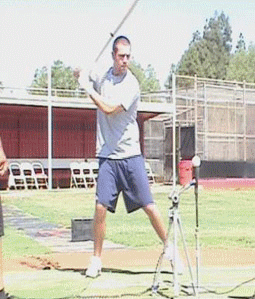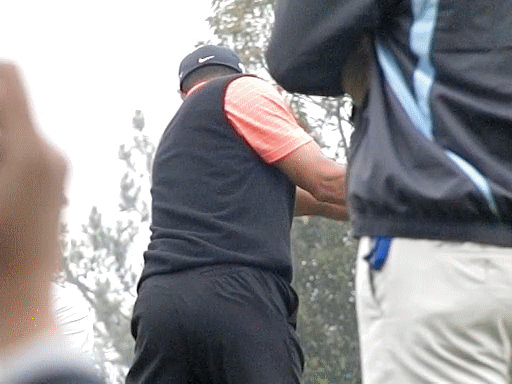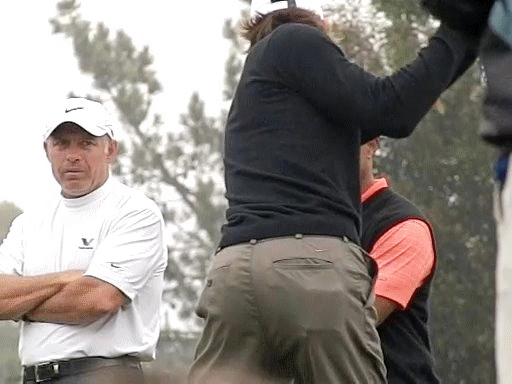Tigers Transition
- by Kelvin Miyahira
If you were to take a look at the swings of the greatest players of all time, you would find a commonality amongst all of them……athleticism.
Just take a look on YouTube to find the great old swings of Bobby Jones, Ben Hogan, Sam Snead, young Jack Nicklaus, Lee Trevino and now Tiger Woods. What you won’t see is cookie cutter looking swings or compact, “efficient” techniques. But what you will see is pure, unadulterated athleticism.
They were not “taught” by using videos, computers, biomechanical sensors or golf teachers in many cases. They just did what was most athletic to them and that’s what made them great. Contrast that with today’s amateur golfers. We’ve got better technologies, better equipment, better instruction but we’re still even close to matching the athleticism of the great, classic players.
So what’s the problem? I think we’re so inundated with “one plane this” or “two plane that” or “stack this” or “rotary that” that somewhere along the line we’ve lost what we instinctually and athletically have. When throwing rocks at the Tyrannosaurus Rex to avoid being his dinner, we learned to throw. We learned to hit with a big stick. If we had to think of what plane we were on in order to hit the predator correctly, surely we’d have become extinct long ago.
Said another way, I’ve never seen a baseball pitcher throw with an incorrect sequence. No one’s arm or shoulder fires before the hips. Yet we see this type of flaws in golfers all the time. Why is that? Poor instruction? Some golf theory has people trying to start the downswing with the shoulders instead of the legs and hips. Imagine that?
So how do we get back to athleticism?
By forgetting the details of a backswing and downswing and then start to work on the most important phase of the golf swing, the transition. It isn’t well understood by many and depending upon whom you talk to, you’ll get different answers. So rather than relying on that, let’s try to define it as we see it by a more detailed analysis.
The Transition
The transition is that critical area of the swing where the backswing ends and the downswing starts. The transition is comprised of two parts: the closed hip bump and the “fall in”. A lateral shift to the left should occur in each of these two phases. But since the lateral shift has already been discussed many times over, we’ll skip that part of the analysis and head straight for what’s truly more important and critical.
This month we will focus on the closed hip bump and next month we’ll explore the “fall in.”
Closed Hip Bump
Baseball pitchers and some very good hitters possess a move that I call the closed hip bump. For a brief moment, while the hips are laterally moving forward, there is actually a little bit of clockwise hip rotation. In other words, these athletes are still turning to complete the backswing while the lateral motion has started. Thus, there is movement in two directions at the same time.
Perry Husband, baseball hitting and pitching expert who appeared in the Fox Sports Network “Sport Science Show,” calls it “turning in.” Notice his hip position as he gets ready to stride forward. He doesn’t have a lot of hip turn at the start. Notice as he starts to pick up the left heel, his hips turn a little more. Then as the foot leaves the ground a little quicker hip turn occurs. It is now that he has ended his move right and will begin to move left on the next frame.

Look at the chair in the background on the side of his left hip for perspective. His hips might be turned say 30 degrees? He’s definitely started forward while still moving back We can see less of the chair behind his left hip yet his hips continue to turn in or clockwise. Hips are still moving forward as evidenced by the chair being completely hidden from view. But his hips have turned even more. Perhaps he’s turned his hips about 40-45 degrees now?
Said in another way, he’s turned his hips in or clockwise about 15 degrees while his hips laterally slid forward. This is the key to the kingdom of power. Contrast that with opening or rotating your hips open while striding forward. That would be the complete opposite. Surely you’ll run out of rotation by that point and miss the sweetspot in time where impact occurs and maximum power applied to the ball by having your body in the mechanically optimum position. Hitters that do this are sometimes so over-rotated that their chest and belt buckle would be facing the mound while contact is made.
Just put yourself in that position and see how powerful you’d be. He’s firmly planted on the left yet has all his hip rotation ready to be used in the swing. If you look at his body, it looks like Tiger’s transition. He would be a great golfer if he wanted to.
Adding Momentum and Ground Force Momentum and Vertical Ground Force
There are two more elements of the transition. Thus far we know there is a lateral motion and a rotational motion. But there are several related elements that are often overlooked, momentum and vertical ground force.
During transition, there should be a build up of momentum. As the weight is transferred over to the left foot there is vertical ground force being applied from the right foot. This force is similar to Bruce Lee’s one-inch punch. In order to develop the high levels of force to knock someone over he must apply a rapid ground force to create some velocity of his whole body. Then his punch really packs a wallop. This happens so fast that it eludes the human eye. Let’s take a look at this more closely.
The equation for momentum is mass times the velocity. But the question first is, “the mass of what?” Is it just the mass of his hand? Think about that one for a moment. Is it just his hand that hits you? Or as I said earlier, does he find a way to use his entire body to hit you? I’d say the latter and there are some great clips on YouTube to prove that his entire body was accelerating in order to add mass to apply the tremendous force needed to knock his opponent back. That’s why I think it is erroneous when some physicists believe that it is ONLY the mass of the golf clubhead that is important. “It is as if it could be swinging on a string” and not attached to a human body, or so they say. “It’s just the mass of the clubhead moving, its velocity and perfect contact that factors into the resultant ball speed.” Oh really? Sorry, I digressed.
The main point of this is that he’s using the ground force to build momentum of his body to add to his power. Tiger does this type of move as well to set up a more massive impact. No Ground Force? Bruce Lee’s punch or Tiger’s drive could not be powerful if they were standing on slippery ice with flat-soled shoes. It’s like ice hockey players who are trying to throw a punch. They slip, slide and spin and find it difficult to get the needed footing to create the ground force. Similarly, a golfer who spins out doesn’t create much ground force either.
This lack of ground force shows up at the start of the downswing. Pushing off the right side is a must. Lateral sliders might have the right ground force starting the downswing, but just before impact, they slide on by forgetting to post up and push into the ground with the left leg. Either way, the lack of ground force is a power loss. Without the ground force there can be no momentum built up and therefore less energy applied to the opponent or ball.
SSC Power and Timing
Largely ignored by golf instructors is the effect of stretch shorten cycles on a golf swing. Instructors simply see this event as a coil, stretch and uncoil of the trunk. Shoulder turn, X-factor and so on. Well, there’s a lot more to this than meets the eye. So let’s just take one slice of the SSC pie and unravel it.
For example, as the knees move forward and the body goes down slightly, the stretch shorten cycle of the powerful lower body becomes primed and ready. The quadriceps, hamstrings, glutes and the hip flexors are stretched during this transition move. If done properly, they should automatically be ready to fire within the time frame of 120 milliseconds to gain maximally from the SSC contraction.
In other words, the correct transition will allow a second, more powerful firing of the legs and hips in addition to this first hip bump. This is a huge source of extra power that everyone is looking for.
Two Ways to Ruin it Whip Theory
Suppose you have good transition -- what could possibly ruin it? I know of two very popular swing theories that would just kill it. One is called the “Whip Theory” and the other is called the “Quiet Lower Body Myth.”
According to the Whip Theory, a golfer fires these segments JUST ONCE. So your hips fire once at the beginning of the downswing then transfers its energy and speed to the shoulders. Then the shoulders transfer its energy and speed to the arms, then to the hands and it eventually reaches the clubhead. He he he. It’s a nice, clean and simple theory for simple minds to understand. But is it really that simple? Is that what Tiger does? Or Jason Zuback? I think not.
Quiet Lower Body Myth
Related to Whip Theory is the “quiet lower body” myth. Imagine if Bruce Lee were to quiet his lower body and not use it for impact. He wouldn’t be able to knock people off their feet. Yet this is what we do in golf today. We quiet the lower body. We sit, we squat, we brace, we follow the upper body but we don’t use it for impact. Curious huh?
If we fire our hips at the start of the downswing then do nothing with it for the next 150 milliseconds, we may as well hit while sitting on a stool. It’s not a bad thing and there are some that can hit it far while sitting down. But seriously, I don’t think there’s anyone that can hit it farther while seated.
With this in mind, take a look at the fabulous transition of Tiger from back view.
Tiger Butt View Transition
When looking from front view, as we are accustomed, sometimes we miss what’s truly important. From the front view we can mistake left hip rotation for lateral motion since the hips are narrower looking when turned than when square. But from the back view we can clearly see these distinctive moves. We can tell if he’s rotating or moving lateral very easily.
Watch as Tiger’s lower body begins to move forward as his arms and club are still completing the backswing. Notice the amount of closed hip bump occurs and how many frames it is occurring in. It isn’t a lot but what is there is so critical. And check out all the creases in his sweater. After the last frame of transition, he can just flat out rip it.

Watch as this top ranked amateur in the US performs a different, less dynamic move than Tiger. He has almost nothing in the way of bi-directional movement and it is much less powerful looking. Not only that, he has a hip stall out right near impact that probably costs him 10-20 yards.

Conclusion
There are a lot of golfers out there with beautiful backswings and nice follow throughs. But somewhere in between the beginning and end of their swing, there’s a lot more work to be done and a lot more power to be gained. It’s like having beautiful new tires and rims on a car that has a sputtering engine. How good is that going to be? So we must work to develop the most critical part of the swing and then the rest of the swing will fall into place.
To do this, we must use our inborn athleticism and trust it. If not we will fall prey to the golf fad of the month that might be promoting athletic nonsense. Next month we’ll tackle what I refer to as the “fall in.” It is another very important element of the transition move.

